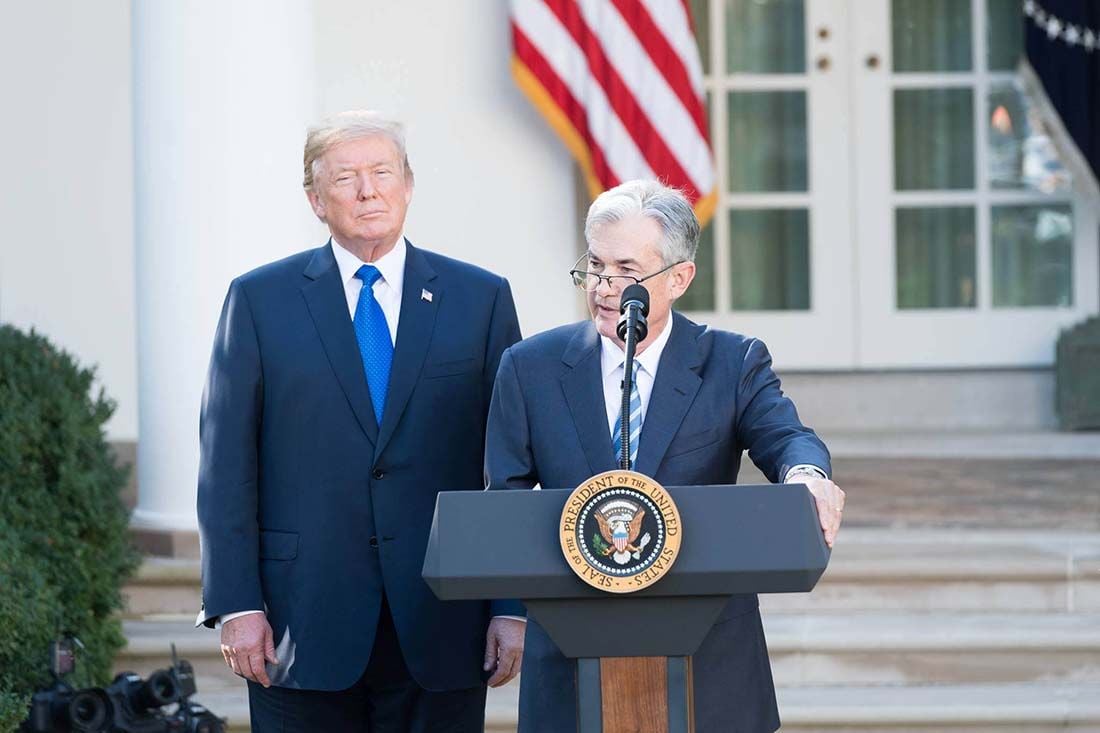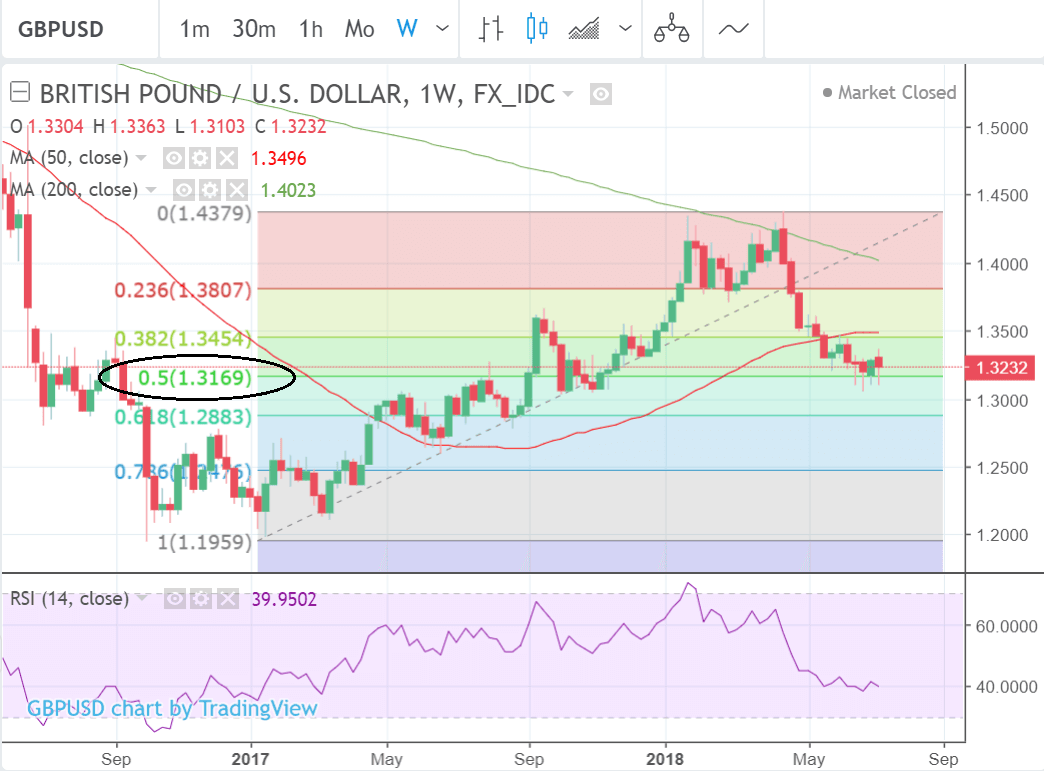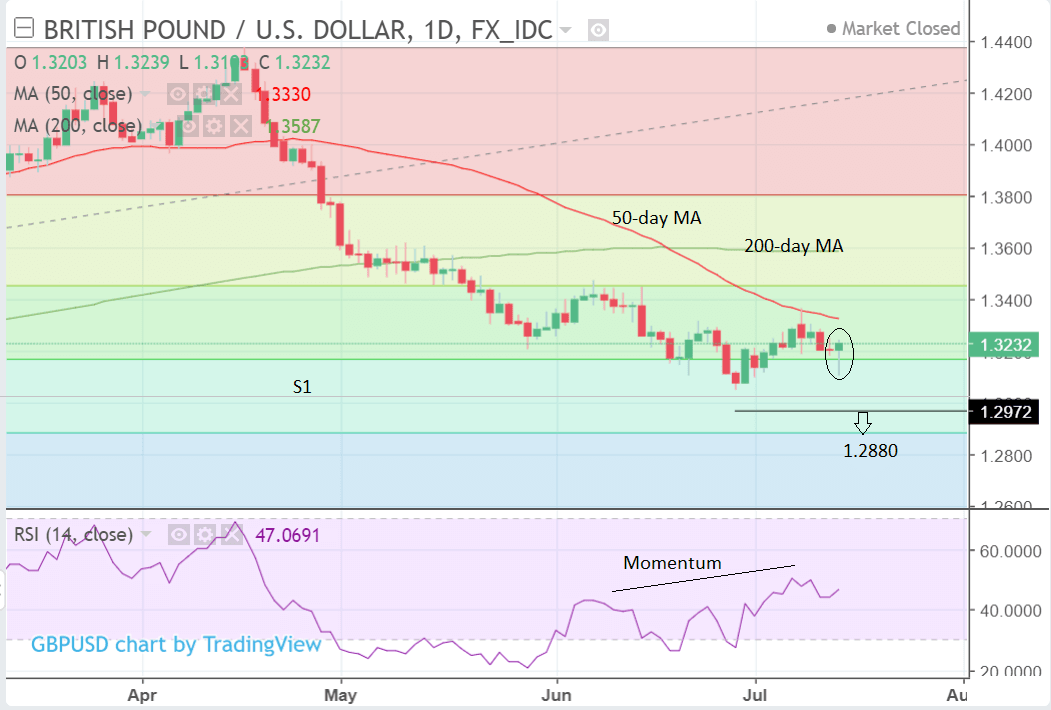The Pound-to-Dollar Rate Outlook for the Week Ahead: Downtrend Liable to Persist
- Despite some bullish signs trend down remains intact
- Break below 1.2975 required for confirmation lower
- Main event for UK is still Brexit machinations; for US Dollar Chairman Powell's testimony

Above: US Federal Reserve Governor Jerome Powell dominates the Dollar's calendar this week. Image © The White House
The Pound-to-Dollar rate is in a short-term downtrend which has reached a level where there is a risk of a reversal. Yet, in the absence of more confirmation, the downtrend is tipped to continue.
The weekly chart - which gives a longer-term view of the market - shows how the exchange rate has declined to the midpoint of the previous rally, also known as the 50% or 0.5 retracement (circled).
This is a key level where corrections often end and the main trend resumes.
The lack of upside so far however suggests it is too early to confirm a reversal and the short-term downtrend remains intact.
Indeed, the downtrend could extend from here down to the next target, although we are more cautiously bearish than before, because of the location of the supportive 50% level.
Ideally, we would like to see a break below 1.2975 for confirmation of the next leg lower, to a probable target at 1.2880, where the 61.8% Fibonacci retracement is situated, another level where prices may stall and reverse trend, like the 50% retracement level.
Whilst we are overall still bearish, there are circumstantial bullish indicators which suggest at least the possibility of a move higher too.
The Japanese hammer candlestick pattern on the daily chart (circled) and the strong upwards momentum as measured by RSI are both positive signs for the exchange rate although on their own they are still not enough for us to revise our bearish stance.
Advertisement
Get up to 5% more foreign exchange by using a specialist provider to get closer to the real market rate and avoid the gaping spreads charged by your bank when providing currency. Learn more here
What to Watch in the Week Ahead for the Dollar
The main event in the week ahead for the Dollar is probably the semi-annual testimony of Federal Reserve (Fed) Chairman Powell before Congress on Tuesday at 14.00 GMT.
Powell will be asked for an update on the economy and his view of where monetary policy is headed. Lawmakers may also ask for an update on the potential impact of Trump's aggressive approach to diplomacy and tariffs, and his stimulative tax cuts. All these issues are pertinent to the Dollar.
The US appears to be undergoing a period of rapid growth which is propelling the US Dollar higher too. It is possible that Powell may say the Fed is adjusting its stance in light of these changes - meaning it could be entertaining an even more aggressive approach to policy and higher interest rates.
If that is the case, Powell's testimony may fuel even more US Dollar strength, as expectations of higher interest rates appreciate currencies by attracting greater inflows of foreign capital, drawn by the promise of higher returns. Although the Fed is already expected to raise rates at a rate of 0.25% per quarter in this year and the next, they are forecast to peak at only 3.5% - if Powell is more bullish, however, this end rate or 'terminal' rate as it is known may also be revised up, and this is likely to drive the Dollar higher too.
Alternatively, Powell may decide to focus on the downside risks of the current trade war on US growth and this would push the Dollar down instead.
"A bigger risk for the greenback is likely to be Fed Chairman Jerome Powell’s testimony before Congress on Tuesday, where he will give his latest monetary policy assessment to US lawmakers. Investors will be watching if the Fed is becoming concerned about overshooting its inflation target and whether the central bank is worried about the impact of the escalating trade tensions on the US economy," says a note from Actionforex on the matter.
Analysts at global investment bank TD Securities expect Powell to simply reiterate the Fed's current 'gradualist' line.
"We expect him to reiterate the case for gradual hikes on the back of a tight labour market but contained inflation. We focus on any comments on trade protectionism and the yield curve along with operational procedures," say TD Securities.
The other main release for the US Dollar is retail sales on Monday at 12.30 GMT, which is forecast to come out at 0.5% in June from the 0.8% rise registered in May. Retail sales Ex Autos is expected to rise 0.4% from 0.9% previously.
What to watch in the week ahead for the Pound
There is a considerable bundle of data and events in the week ahead for Sterling, which suggests it could be a highly volatile time for the currency.
On the political front there will be votes on amendments to the Trade and Customs Bill, which help form the basis of the government's new 'softer' Brexit proposal. These are expected to take place on Monday 16 and Tuesday 17.
They could be critical in gauging whether the plan has a likelihood of success and implementation.
"Another legislative showdown takes place in the UK House of Commons as the Trade and Customs Bills are voted on. Amendments to the bill have come from 'hard' Brexiteers (trying to undo the white paper) and Remainers (trying to bind the UK to a customs union). Some of these votes could come down to the wire, and have significant implications for Brexit negotiations," says Actionforex.com in their week ahead analysis.
Sterling may catch a bid if Brexit supporters in the Conservative party fail in their upcoming attempt to harden the UK government's plan on leaving the EU, as failure should increase the GBP-positive probability of a relatively soft Brexit.
We note a string of opinion polls out over recent days that shows support for the Convervatives has fallen below that of Labour with a good proportion of voters flocking back to UKIP having judged that May will not deliver the Brexit they desire.
This will remind Convervative lawmakers that bringing down the government will likely throw their party onto the opposition benches. It does also however offer the potential to sharpen the determination of Brexiteers who believe their electoral success will lie with delivering a clean 'hard' Brexit.
From a 'hard' data perspective the week has three major, potentially market moving, releases too: labour market data on Tuesday, CPI on Wednesday and retail sales on Thursday - all are at 9.30 UK time (8.30 GMT).
Their significance is further heightened by the fact that they may impact on the decision-making of the Bank of England (BOE) when it has its pivotal meeting in August. Because the probabilities of a hike or not, are so evenly balanced, next week's data could prove critical in swinging the vote one way or another.
Labour market data for May, is expected to show continued improvement with a 150K rise in employment on a three-month-on-three-month basis.
The more important wage data component of the release, which is more of an influence on inflation and therefore Bank of England decision-making, is expected to show only modest rises of 2.6% for headline and 2.8% (including bonuses).
Stronger wage rises are necessary to increase the chances of a rate hike and a disappointment could weigh heavily on Sterling.
CPI inflation data in June, out on Wednesday, is likely to show a rise due to the temporary influence of higher oil prices, however, if the main driver is in fact only fuel prices, it is unlikely to have much impact on the Bank of England who are more likely to look through inflation from temporary factors.
Therefore we believe the core CPI reading will be of more interest to the Bank of England as it shows the underlying inflationary pressures present in the economy.
Core CPI is forecast to read at 2.1% (month-on-month) while headline CPI is forecast to read at 0.2% month-on-month and 2.6% year-on-year.
"We suspect that CPI inflation edged up to 2.6% in June, owing to a rise in energy prices. But this should not mark the start of a sustained rise," says Andrew Wishart, UK economist at Capital Economics.
Retail sales for June are set for release on Thursday but the "evidence on strength," says Capital Economic's Wishart, "has been decidedly mixed."
On the one hand, the strong data in April and May will be a hard act to follow in June, yet on the other hand factors such as the good weather and the World Cup could support a rise.
"More sunshine, warm weather, and World Cup should be supportive. Our base case 0.4% forecast leaves a very strong trend for Q2 sales, and a solid hand-off to Q3," says TD securities in their note on data in the week ahead.
Markets are forecasting a reading of 0.4% on a month-on-month basis and 3.9% annualised.
Advertisement
Get up to 5% more foreign exchange by using a specialist provider to get closer to the real market rate and avoid the gaping spreads charged by your bank when providing currency. Learn more here


